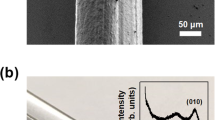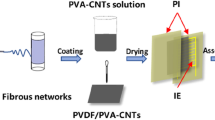Abstract
The combination of conductive material and flexible material is an unavoidable problem in the preparation of flexible sensor, but uniform combination of the materials in micro- or nanostructure is difficult. Coaxial electrospinning is an effective way to realize the combination, which is very strict for the solutions and the synthesis conditions. In this paper, composite pH-sensitive sensors were developed by coaxial electrospinning of polyaniline (PANI) and polyurethane (PU) into core–shell fibers. PU improved the mechanical properties of the sensors. The mechanical properties and conductivity of the sensor can be changed through adjusting the proportion of PANI and PU. By chronopotentiometry in buffer solutions, the sensor worked linearly in the pH range of 2–7 with the sensitivity of − 60 mV/pH and pH change below 0.2 can be detected. It was also proved that the sensor can resist the influence from the changes in temperature, detection time and deformation of the sensor, ensuring the stability in pH detection. Further, by attaching to skin, our sensor showed the response to the pH of small amount of sweat on the skin surface, which suggested the possibility in wearable devices.
Graphic abstract










Similar content being viewed by others
References
Djogo G, Jianzhao L, Ho S, Haque M, Ertorer E, Jun L, Xiaolu S, Jing S, Herman PR (2019) Femtosecond laser additive and subtractive micro-processing: enabling a high-channel-density silica interposer for multicore fibre to silicon-photonic packaging. J Intell Manuf 1:45002–45009. https://doi.org/10.1088/2631-7990/ab4d51
Pomerantseva E, Bonaccorso F, Feng X, Cui Y, Gogotsi Y (2019) Energy storage: the future enabled by nanomaterials. Science 366:969. https://doi.org/10.1126/science.aan8285
Wu X, Huang B, Lv R, Wang Q, Wang Y (2019) Highly flexible and low capacitance loss supercapacitor electrode based on hybridizing decentralized conjugated polymer chains with MXene. Chem Eng J 378:122246. https://doi.org/10.1016/j.cej.2019.122246
Meng Q, Liu Z, Han S, Xu L, Araby S, Cai R, Zhao Y, Lu S, Liu T (2019) A facile approach to fabricate highly sensitive, flexible strain sensor based on elastomeric/graphene platelet composite film. J Mater Sci 54:10856–10870. https://doi.org/10.1007/s10853-019-03650-1
Zhu J, Wang Z, Lin S, Jiang S, Liu X, Guo S (2019) Low-cost flexible plasmonic nanobump metasurfaces for label-free sensing of serum tumor marker. Biosens Bioelectron 150:111905. https://doi.org/10.1016/j.bios.2019.111905
Costa JC, Spina F, Lugoda P, Garcia-Garcia L, Roggen D, Munzenrieder N (2019) Flexible sensors-from materials to applications. Technologies 7:35. https://doi.org/10.3390/technologies7020035
Sun Q, Qian B, Uto K, Chen J, Liu X, Minari T (2018) Functional biomaterials towards flexible electronics and sensors. Biosens Bioelectron 119:237–251. https://doi.org/10.1016/j.bios.2018.08.018
Liu Z, Qi D, Leow WR, Yu J, Xiloyannnis M, Cappello L, Liu Y, Zhu B, Jiang Y, Chen G, Masia L, Liedberg B, Chen X (2018) 3D-structured stretchable strain sensors for out-of-plane force detection. Adv Mater 30:170728526. https://doi.org/10.1002/adma.201707285
Rahimi R, Ochoa M, Tarnayol A, Khalili S, Khademhosseini A, Ziaie B (2017) Highly stretchable potentiometric pH sensor fabricated via laser carbonization and machining of carbon-polyaniline composite. ACS Appl Mater Inter 9:9015–9023. https://doi.org/10.1021/acsami.6b16228
Zhang C, Li H, Huang A, Zhang Q, Rui K, Lin H, Sun G, Zhu J, Peng H, Huang W (2019) Rational design of a flexible CNTs@PDMS film patterned by bio-inspired templates as a strain sensor and supercapacitor. Small 15:180549318. https://doi.org/10.1002/smll.201805493
Wang N, Xu Z, Zhan P, Dai K, Zheng G, Liu C, Shen C (2017) A tunable strain sensor based on a carbon nanotubes/electrospun polyamide 6 conductive nanofibrous network embedded into poly(vinyl alcohol) with self-diagnosis capabilities. J Mater Chem C 5:4408–4418. https://doi.org/10.1039/c7tc01123g
Wang Q, Zhang Y, Ye W, Wang C (2016) Ni(OH)(2)/MoS(x) nanocomposite electrodeposited on a flexible CNT/PI membrane as an electrochemical glucose sensor: the synergistic effect of Ni(OH)(2) and MoS(x). J Solid State Electr 20:133–142. https://doi.org/10.1007/s10008-015-3002-9
Gokoglan TC, Soylemez S, Kesik M, Dogru IB, Turel O, Yuksel R, Unalan HE, Toppare L (2017) A novel approach for the fabrication of a flexible glucose biosensor: the combination of vertically aligned CNTs and a conjugated polymer. Food Chem 220:299–305. https://doi.org/10.1016/j.foodchem.2016.10.023
Yang H, Leow WR, Chen X (2018) 3D printing of flexible electronic devices. Small Methods 2:UNSP17002591. https://doi.org/10.1002/smtd.201700259
Imani S, Bandodkar AJ, Mohan AMV, Kumar R, Yu S, Wang J, Mercier PP (2016) A wearable chemical-electrophysiological hybrid biosensing system for real-time health and fitness monitoring. Nat Commun 7:11650. https://doi.org/10.1038/ncomms11650
Kweon OY, Lee SJ, Oh JH (2018) Wearable high-performance pressure sensors based on three-dimensional electrospun conductive nanofibers. NPG Asia Mater 10:540–551. https://doi.org/10.1038/s41427-018-0041-6
Li Y, Mao Y et al (2020) Flexible pH sensor based on a conductive PANI membrane for pH monitoring. RSC Adv 10(1):21–28. https://doi.org/10.1039/c9ra09188b
Guinovart T, Valdes-Ramirez G, Windmiller JR, Andrade FJ, Wang J (2014) Bandage-based wearable potentiometric sensor for monitoring wound pH. Electroanal 26:1345–1353. https://doi.org/10.1002/elan.201300558
Angammana CJ, Jayaram SH (2016) Fundamentals of electrospinning and processing technologies. Particul Sci Technol 34(1):72–82. https://doi.org/10.1080/02726351.2015.1043678
Macagnano A, Perri V, Zampetti E, Bearzotti A, De Cesare F (2016) Humidity effects on a novel eco-friendly chemosensor based on electrospun PANi/PHB nanofibres. Sens Actuat B Chem 232:16–27. https://doi.org/10.1016/j.snb.2016.03.055
Li R, Chen S, Lou Z, Li L, Huang T, Song Y, Chen D, Shen G (2017) Fabrication of porous SnO2 nanowires gas sensors with enhanced sensitivity. Sens Actuat B Chem 252:79–85. https://doi.org/10.1016/j.snb.2017.05.161
Chen J, Xu L, Xing R, Song J, Song H, Liu D, Zhou J (2012) Electrospun three-dimensional porous CuO/TiO2 hierarchical nanocomposites electrode for nonenzymatic glucose biosensing. Electrochem Commun 20:75–78. https://doi.org/10.1016/j.elecom.2012.01.032
Rana U, Paul ND, Mondal S, Chakraborty C, Malik S (2014) Water soluble polyaniline coated electrode: a simple and nimble electrochemical approach for ascorbic acid detection. Synth Met 192:43–49. https://doi.org/10.1016/j.synthmet.2014.03.013
Smirnov MA, Tarasova EV, Vorobiov VK, Kasatkin IA, Mikli V, Sokolova MP, Bobrova NV, Vassiljeva V, Krumme A, Yakimanskiy AV (2019) Electroconductive fibrous mat prepared by electrospinning of polyacrylamide-g-polyaniline copolymers as electrode material for supercapacitors. J Mater Sci 54:4859–4873. https://doi.org/10.1007/s10853-018-03186-w
Yan T, Zhang M, Jiang J, Chen N (2019) Synthesis of DBSA-doped polyaniline by emulsion polymerization and PANI/PLA electrospun fiber membrane conductivity. J Text I 110:274–281. https://doi.org/10.1080/00405000.2018.1477318
Bertuoli PT, Ordono J, Armelin E, Perez-Amodio S, Baldissera AF, Ferreira CA, Puiggali J, Engel E, Del Valle LJ, Aleman C (2019) Electrospun conducting and biocompatible uniaxial and core-shell fibers having poly(lactic acid), poly(ethylene glycol), and polyaniline for cardiac tissue engineering. ACS Omega 4:3660–3672. https://doi.org/10.1021/acsomega.8b03411
Farkhondehnia H, Tehran MA, Zamani F (2018) Fabrication of biocompatible PLGA/PCL/PANI nanofibrous scaffolds with electrical excitability. Fiber Polym 19:1813–1819. https://doi.org/10.1007/s12221-018-8265-1
Qiu H, Song W, Wang X, Zhang J, Fan Z, Yu M, Ramakrishna S, Long Y (2019) A calibration-free self-powered sensor for vital sign monitoring and finger tap communication based on wearable triboelectric nanogenerator. Nano Energy 58:536–542. https://doi.org/10.1016/j.nanoen.2019.01.069
Fu Y, An Q, Ni R, Zhang Y, Li Y, Ke H (2018) Preparation of polyaniline-encapsulated carbon/copper composite nanofibers for detection of polyphenol pollutant. Colloid Surface A 559:289–296. https://doi.org/10.1016/j.colsurfa.2018.09.065
Tong L, Wang X, He X, Nie G, Zhang J, Zhang B, Guo W, Long Y (2018) Electrically conductive TPU nanofibrous composite with high stretchability for flexible strain sensor. Nanoscale Res Lett 13:86. https://doi.org/10.1186/s11671-018-2499-0
Li D, Huang J, Kaner RB (2009) Polyaniline Nanofibers: a unique polymer nanostructure for versatile applications. Acc Chem Res 42:135–145. https://doi.org/10.1021/ar800080n
Rajender B, Palaniappan S (2015) Organic solvent soluble methyltriphenylphosphonium peroxodisulfate: A novel oxidant for the synthesis of polyaniline and the thus prepared polyaniline in high performance supercapacitors. New J Chem 39:5382–5388. https://doi.org/10.1039/c5nj00979k
Fatema UK, Rahman MM, Islam MR, Mollah MYA, Susan MABH (2018) Nanocomposites of polyaniline with silver nanoparticles prepared using water in oil microemulsions as antibacterial agents. Macromol Symp 379:UNSP1700031. https://doi.org/10.1002/masy.201700031
Salaneck WR, Liedberg B, Inganas O, Erlandsson R, Lundstrom I (1985) Physical characterization of some polyaniline, (phiN)x. Mol Cryst Liq Cryst 121:191–194. https://doi.org/10.1080/00268948508074860
Dimitriev OP, Lavrik NV (1997) Protonation and charge transfer in poly-aniline: an optical absorption study of the mixed solutions. Synth Met 90:1–4. https://doi.org/10.1016/S0379-6779(97)03882-4
Karaoğlan N, Bindal C (2018) Synthesis and optical characterization of benzene sulfonic acid doped polyaniline. Eng Sci Technol 21:1152–1158. https://doi.org/10.1016/j.jestch.2018.09.010
Burugapalli K, Wijesuriya S, Wang N, Song W (2018) Biomimetic electrospun coatings increase the in vivo sensitivity of implantable glucose biosensors. J Biomed Mater Res A 106:1072–1081. https://doi.org/10.1002/jbm.a.36308
Nazari H, Azadi S, Hatamie S, Zomorrod MS, Ashtari K, Soleimani M, Hosseinzadeh S (2019) Fabrication of graphene-silver/polyurethane nanofibrous scaffolds for cardiac tissue engineering. Polym Adv Technol 30:2086–2099. https://doi.org/10.1002/pat.4641
Jaganathan SK, Mani MP, Nageswaran G, Krishnasamy NP, Ayyar M (2018) Single stage electrospun multicomponent scaffold for bone tissue engineering application. Polym Test 70:244–254. https://doi.org/10.1016/j.polymertesting.2018.07.015
Preety HV (2018) A novel polyurethane/nano ZnO matrix for immobilization of chitinolytic enzymes and optical sensing of chitin. Int J Biol Macromol 106:1173–1183. https://doi.org/10.1016/j.ijbiomac.2017.08.114
Gokce ZG, Akalin P, Kok FN, Sarac AS (2018) Impedimetric DNA biosensor based on polyurethane/poly(m-anthranilic acid) nanofibers. Sens Actuat B Chem 254:719–726. https://doi.org/10.1016/j.snb.2017.07.136
Kalakodimi RP, Nookala M (2002) Electrooxidation of ascorbic acid on a polyaniline-deposited nickel electrode: Surface modification of a non-platinum metal for an electrooxidative analysis. Anal Chem 74:5531–5537. https://doi.org/10.1021/ac025938k
Oh SY, Hong SY, Jeong YR, Yun J, Park H, Jin SW, Lee G, Oh JH, Lee H, Lee S, Ha JS (2018) Skin-attachable, stretchable electrochemical sweat sensor for glucose and pH detection. ACS Appl Mater Inter 10:13729–13740. https://doi.org/10.1021/acsami.8b03342
Acknowledgements
This work was supported by National Key Research and Development Project, China (2019YFE0101200). The authors appreciated Professor Aiguo Kong and his students for the help of electrochemical testing.
Author information
Authors and Affiliations
Corresponding author
Ethics declarations
Conflict of interest
The authors declare that they have no known competing financial interests or personal relationships that could have appeared to influence the work reported in this paper.
Additional information
Handling Editor: Gregory Rutledge.
Publisher's Note
Springer Nature remains neutral with regard to jurisdictional claims in published maps and institutional affiliations.
Electronic supplementary material
Below is the link to the electronic supplementary material.
Rights and permissions
About this article
Cite this article
Hou, X., Zhou, Y., Liu, Y. et al. Coaxial electrospun flexible PANI//PU fibers as highly sensitive pH wearable sensor. J Mater Sci 55, 16033–16047 (2020). https://doi.org/10.1007/s10853-020-05110-7
Received:
Accepted:
Published:
Issue Date:
DOI: https://doi.org/10.1007/s10853-020-05110-7




